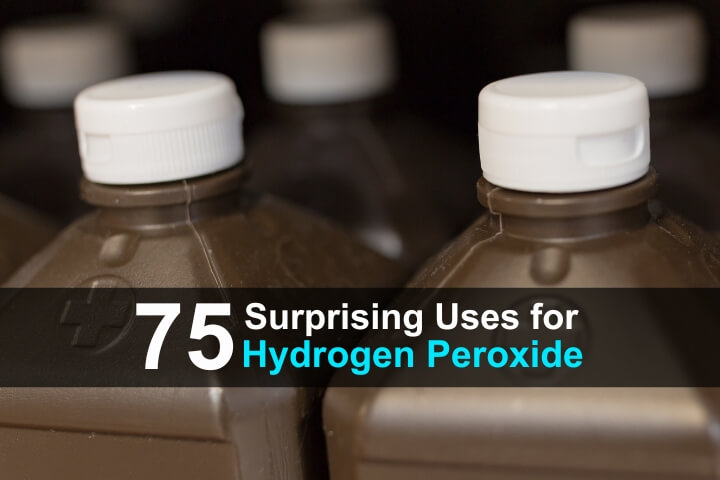Estimated reading time: 17 minutes
Hydrogen peroxide is one of the most useful substances ever discovered. Chemically, it’s made up of hydrogen and oxygen (H?O?), giving it powerful oxidizing abilities that make it highly effective at killing bacteria, fungi, and viruses.
This versatile substance is often found in first aid kits, but its uses extend far beyond wound care, proving to be an essential tool for cleaning, gardening, survival, and even pest control.
What makes hydrogen peroxide so useful is its ability to sanitize, deodorize, and even break down organic matter, all without leaving toxic residues behind. This makes it a safer choice for households focused on non-toxic solutions.
Throughout this article, you’ll discover a range of interesting uses for hydrogen peroxide, from extending the life of fresh flowers to disinfecting your toothbrush and even helping to germinate seeds.
Whether you’re looking to brighten your laundry, repel insects, or preserve food, hydrogen peroxide offers a surprising number of solutions for everyday needs.
Want to save this post for later? Click Here to Pin It On Pinterest!
Cleaning Uses for Hydrogen Peroxide
Brighten Floors
How to Use: Add 1/4 cup of 3% hydrogen peroxide to a gallon of warm water. Use this solution to mop hard floors, such as tile, vinyl, or linoleum. It helps remove grime, disinfect, and brighten surfaces.
Frequency: Use once a month or as needed for a deep clean. Avoid using too frequently on floors that could be sensitive to hydrogen peroxide, and always test in a small, inconspicuous area first.
Clean Counters
How to Use: Spray 3% hydrogen peroxide directly on countertops. Let it sit for 5 minutes to disinfect, then wipe with a clean cloth.
Frequency: Use daily or as needed.
Clean Cutting Boards
How to Use: Spray a 3% hydrogen peroxide solution on the cutting board. Let it sit for a few minutes, then rinse with water and dry.
Frequency: Use after each use with raw meat or to remove odors.
Clean Glass
How to Use: Spray 3% hydrogen peroxide on glass surfaces and wipe with a microfiber cloth for a streak-free shine.
Frequency: Use as needed.
Clean Shower Curtains
How to Use: Spray 3% hydrogen peroxide directly on the shower curtain to remove mildew. For deep cleaning, add 1/2 cup hydrogen peroxide to a washing machine load with the curtain.
Frequency: Use weekly or as needed.
Clean Sinks
How to Use: Spray 3% hydrogen peroxide in the sink, let it sit for 10 minutes, then scrub and rinse thoroughly.
Frequency: Weekly or as needed.
Clean Sponges
How to Use: Soak sponges in a bowl of 1:1 hydrogen peroxide and water for 10 minutes, then rinse and squeeze out excess water.
Frequency: Every few days to keep sponges fresh.
Clean the Refrigerator
How to Use: Spray 3% hydrogen peroxide on refrigerator surfaces, including shelves and drawers, let sit for 5 minutes, then wipe clean.
Frequency: Monthly or as needed.
Clean Tiles
How to Use: Spray 3% hydrogen peroxide on tile surfaces and let it sit for 5-10 minutes to disinfect and remove grime. Wipe with a cloth or sponge.
Frequency: Weekly or as needed.
Clean Toilets
How to Use: Pour 1/2 cup of 3% hydrogen peroxide around the inside rim of the toilet bowl. Let sit for 20 minutes, then scrub with a toilet brush and flush.
Frequency: Weekly or as needed.
Clean Tubs
How to Use: Spray 3% hydrogen peroxide on tub surfaces. Let it sit for 10 minutes, then scrub and rinse.
Frequency: Weekly or as needed.
Disinfect Toothbrushes
How to Use: Soak toothbrushes in 3% hydrogen peroxide for 5 minutes, then rinse with water.
Frequency: Weekly to keep bacteria levels down.
Kill Mold
How to Use: Spray 3% hydrogen peroxide directly on moldy surfaces and let it sit for 10–15 minutes. Scrub the area with a brush, then rinse and dry.
Frequency: Use as needed, especially in damp areas.
Remove Carpet Stains
How to Use: Mix 1 part hydrogen peroxide with 2 parts water. Spray the stain and blot with a cloth, being careful to test for colorfastness first.
Frequency: Use as needed for stains.
Remove Clothing Stains
How to Use: Dab 3% hydrogen peroxide directly on stains (especially blood stains) and let it sit for 5 minutes. Rinse and wash as usual.
Frequency: As needed, especially for fresh stains.
Remove Mildew
How to Use: Spray a 3% hydrogen peroxide solution on areas with mildew, let it sit for 10–15 minutes, then scrub with a brush and rinse.
Frequency: Weekly in damp areas or as needed.
Remove Pet Stains
How to Use: Mix equal parts 3% hydrogen peroxide and water, spray on the pet stain, let it sit for 10 minutes, then blot dry.
Frequency: As needed for odor and stain removal.
Restore Grimy Baking Sheets
How to Use: Sprinkle baking soda generously over the baking sheet, then pour enough 3% hydrogen peroxide to make a thick paste (about 2-3 tablespoons, depending on the size of the baking sheet). Spread the paste evenly over the surface and let it sit for at least 30 minutes to loosen grime. Afterward, scrub with a sponge or brush, then rinse with warm water.
Frequency: Use as needed, whenever baking sheets have built-up residue or tough stains.
Wash Vegetables
How to Use: Mix 1/4 cup of 3% hydrogen peroxide in a sink or large bowl of cold water. Soak vegetables for 5 minutes, then rinse with plain water.
Frequency: Use before storing or consuming vegetables.
Whiten Clothes
How to Use: Add 1 cup of 3% hydrogen peroxide to a load of white laundry. This helps brighten whites and remove stains.
Frequency: Use as needed.
Whiten Grout
How to Use: Mix 1 part hydrogen peroxide with 1 part baking soda to form a paste. Apply to grout, let it sit for 5–10 minutes, then scrub with a brush and rinse.
Frequency: Monthly or as needed for bright, clean grout.
Whiten Sneakers
How to Use: For white sneakers with stubborn stains or scuffs, mix a paste of hydrogen peroxide and baking soda. Apply to the stains with a toothbrush, scrub gently, and let it sit for about 30 minutes before wiping off.
Frequency: Use as needed to keep sneakers looking fresh and clean.
Gardening Uses for Hydrogen Peroxide
Control Powdery Mildew
How to Use: Mix 1 tablespoon of 3% hydrogen peroxide in a quart (32 oz) of water. Pour the solution into a spray bottle and spray it onto affected plant leaves, covering both sides.
Frequency: Apply every 3–4 days until the mildew clears up.
Disinfect Garden Tools
How to Use: Pour 3% hydrogen peroxide directly onto a clean cloth or dip tools into a container of hydrogen peroxide. Wipe down or soak the tools for about 5 minutes, then rinse and dry thoroughly.
Frequency: Disinfect tools after each use, especially when pruning diseased plants.
Germinate Seeds
How to Use: Soak seeds in a solution of 1 ounce of 3% hydrogen peroxide and 1 pint of water for 5 minutes, then rinse with water and plant as usual.
Frequency: Use once, just before planting.
Grow Mushrooms
How to Use: For mushroom cultivation, mist growing substrates with a solution of 1 part 3% hydrogen peroxide to 10 parts water. This keeps competing molds and bacteria away without harming mushroom mycelium.
Frequency: Mist as needed, typically 1-2 times per week.
Help Plants Grow
How to Use: Dilute 1 teaspoon of 3% hydrogen peroxide in a cup of water and use it to water plants, especially if they look stressed or need a growth boost.
Frequency: Apply every 2-3 weeks, as too much can harm plant roots.
Increase Aeration in Hydroponics
How to Use: Add 1 teaspoon of 3% hydrogen peroxide per gallon of water in hydroponic systems. This oxygenates the water, supporting healthier roots.
Frequency: Refresh with each water change, typically weekly.
Keep Pests Away
How to Use: Mix 1/4 cup of 3% hydrogen peroxide in 1 quart of water. Spray on plant leaves and stems to deter common pests like aphids and spider mites.
Frequency: Use weekly or as needed to prevent pests.
Kill Weeds
How to Use: Use 10% hydrogen peroxide (diluted to approximately 5% with equal parts water) and spray directly on weeds. Be careful not to spray desired plants, as it can harm them as well.
Frequency: Apply once, targeting only the weeds, and wait for them to dry out.
Preserve Garden Cuttings
How to Use: When propagating plants, add a few drops of 3% hydrogen peroxide to the water in which you place cuttings. This helps prevent bacterial growth, improving the success rate of root formation.
Frequency: Use once when initially placing the cuttings in water, refreshing as needed when changing the water.
Prevent Root Rot
How to Use: Add 1 tablespoon of 3% hydrogen peroxide to 1 cup of water, then water plants as usual. This adds oxygen to the soil, preventing root rot.
Frequency: Apply every 2 weeks, especially for plants prone to root rot.
Revive Wilted Plants
How to Use: Mix 1 teaspoon of 3% hydrogen peroxide per cup of water and water the wilting plant’s base, providing an oxygen boost to the roots.
Frequency: Use once for immediate support, then resume regular care.
Sterilize Potting Soil
How to Use: Spray potting soil lightly with a mixture of 1 part 3% hydrogen peroxide to 1 part water, ensuring even coverage without soaking.
Frequency: Do this just before planting new seeds or transplants.
Stop Bacterial Rot
How to Use: Mix 1 tablespoon of 3% hydrogen peroxide in 1 cup of water and apply to areas affected by rot. For root vegetables, you can pour the solution over the soil around the base.
Frequency: Use once initially, and monitor for signs of further rot.
Treat Fungal Infections
How to Use: Spray infected plants with a solution of 1 tablespoon of 3% hydrogen peroxide in a quart of water. Be sure to coat both sides of the leaves.
Frequency: Apply every 3 days until the infection subsides.
Clean Your Teeth
How to Use: Mix equal parts of 3% hydrogen peroxide and water to create a mouth rinse. Swish about 1 tablespoon in your mouth for 30–60 seconds, then spit it out.
Frequency: Use 1-2 times per week for whitening or bacteria reduction, but avoid daily use to prevent enamel damage.
Cure Boils
How to Use: Dab a cotton ball soaked in 3% hydrogen peroxide on the boil and hold it for a few minutes. Repeat twice daily until the boil reduces in size.
Frequency: 2 times per day until the boil improves, taking care to avoid irritation.
Cure Rashes
How to Use: Dilute hydrogen peroxide with an equal amount of water. Soak a cloth or cotton pad in the solution and apply to the rash for 1–2 minutes, then rinse off with water.
Frequency: Once daily, monitoring skin for irritation.
Freshen Your Breath
How to Use: Mix equal parts of 3% hydrogen peroxide and water. Swish 1 tablespoon of the mixture in your mouth for about 30 seconds, then spit out and rinse with water.
Frequency: Use every other day for fresh breath and bacteria control.
How to Use: Soak feet in a mixture of equal parts 3% hydrogen peroxide and water. Submerge your feet for 15–20 minutes, then pat dry.
Frequency: Once daily until the fungus clears up.
Get Rid of Ear Wax
How to Use: Place 1-2 drops of 3% hydrogen peroxide in the ear canal using a dropper. Let it sit for about 5 minutes, then tilt your head to let it drain out. Wipe the ear clean with a tissue or cloth.
Frequency: Use as needed, but avoid overuse as it can dry the ear canal.
Kill Mites
How to Use: Apply a few drops of hydrogen peroxide directly to areas where mites may be present, like around the ear or on pet fur. Be cautious to avoid the eyes and open wounds.
Frequency: Use once a day until the mites are no longer visible.
Prevent Body Odor
How to Use: Mix hydrogen peroxide and water in a 1:1 ratio. Dab the mixture onto the armpits using a cotton pad to reduce odor-causing bacteria.
Frequency: Use once daily or as needed.
Reduce Dandruff
How to Use: Dilute 3% hydrogen peroxide with equal parts water. Apply the mixture to the scalp, leave it on for 10 minutes, and rinse thoroughly with water.
Frequency: Use 1-2 times a week to avoid scalp irritation.
Soothe a Sore Throat
How to Use: Gargle with a solution of 1 tablespoon of 3% hydrogen peroxide in 1/2 cup of water for about 30 seconds, then spit out and rinse with plain water.
Frequency: Once daily until symptoms improve.
Soothe Bug Bites
How to Use: Apply a cotton ball soaked in 3% hydrogen peroxide directly to the bite. Let it dry naturally.
Frequency: Apply as needed for relief.
Soothe Minor Burns
How to Use: After cooling the burn with cold water, dab a cotton ball with 3% hydrogen peroxide and apply it to the affected area to prevent infection.
Frequency: Once initially, then as needed if infection is a concern.
Soothe Tooth Pain
How to Use: Rinse your mouth with a mixture of equal parts 3% hydrogen peroxide and water for about 30 seconds, then spit out and rinse with plain water.
Frequency: Use once daily as needed for pain relief.
Treat Acne
How to Use: Dab a cotton swab dipped in 3% hydrogen peroxide directly onto pimples. Leave it on for a few minutes, then rinse with water.
Frequency: Once daily or every other day, avoiding overuse to prevent skin dryness.
Treat Canker Sores
How to Use: Mix equal parts 3% hydrogen peroxide and water, then dip a cotton swab into the solution and apply it to the canker sore. Let it sit for a few minutes, then rinse with water.
Frequency: Twice daily until the sore heals.
Treat Ear Infections
How to Use: Place 2–3 drops of 3% hydrogen peroxide into the affected ear. Let it bubble and sit for a few minutes, then tilt your head to drain it out and wipe with a tissue.
Frequency: Once daily until symptoms improve, but consult a healthcare provider if severe symptoms persist.
Treat Sinus Infections
How to Use: Dilute a small amount of hydrogen peroxide (1 teaspoon of 3%) with one cup of distilled water. Use as a nasal rinse with a neti pot or nasal spray.
Frequency: Once daily, but discontinue if irritation occurs and seek medical advice if needed.
Treat Swimmer’s Ear
How to Use: Place 1–2 drops of 3% hydrogen peroxide in the affected ear, allowing it to bubble for a few minutes before tilting your head to drain.
Frequency: Use once per day until the ear feels dry and discomfort subsides.
Survival Uses for Hydrogen Peroxide
Barter With It
How to Use: Keep hydrogen peroxide in small, unopened containers if possible, as it will be valuable for cleaning, disinfecting, and first aid in a survival situation. Offer it as-is, explaining its benefits for barter.
Clean and Preserve Animal Hides
How to Use: Dilute 3% hydrogen peroxide with an equal part of water. Lightly spray or dab the mixture on the hide to remove blood, bacteria, and odor. Allow the hide to dry in a shaded, well-ventilated area.
Frequency: Use once during the initial cleaning and preservation process, as needed.
Clean Firearms
How to Use: Dip a soft cloth in 3% hydrogen peroxide and gently wipe down the gun’s exterior to remove dirt and potential pathogens. Use a very small amount on a cloth for the internal components but avoid excess, as hydrogen peroxide can be corrosive if left on metal.
Frequency: Use sparingly after each use in a survival scenario, ensuring firearms are thoroughly dried and oiled afterward to prevent rust.
Clean Fishing Gear
How to Use: Soak fishing hooks, lures, and small equipment in a solution of 1 part 3% hydrogen peroxide to 1 part water for 5–10 minutes. Rinse thoroughly and dry to prevent rust.
Frequency: After each use to maintain cleanliness and prevent bacteria or parasites.
Clean Wounds
How to Use: Use a 3% hydrogen peroxide solution directly on cuts or scrapes. Pour a small amount onto a clean cotton ball or gauze and gently dab the wound. You can also pour it directly over the wound to rinse it.
Frequency: Once initially, then only as needed, as too frequent use can slow healing by affecting skin cells.
Extend Shelf Life of Water
How to Use: Add 1/2 teaspoon of 3% hydrogen peroxide per gallon of stored water to prevent bacterial growth. Shake well and store in a cool, dark place.
Frequency: Use once when initially storing the water, but inspect periodically.
Preserve Food
How to Use: For vegetables and fruits, rinse them in a solution of 1 tablespoon of 3% hydrogen peroxide per quart of water for about 5 minutes. Rinse with plain water and let them dry before storing.
Frequency: Use once, immediately after harvesting or purchasing.
Purify Water
How to Use: For small amounts, add 1/8 teaspoon of 3% hydrogen peroxide per gallon of water. Stir well and let it sit for at least 30 minutes before drinking. This method is supplementary to other water purification methods and is best used in combination with filtering.
Frequency: Only use as a temporary measure when safer purification options are unavailable.
Sterilize Storage Containers
How to Use: Pour 3% hydrogen peroxide into the container and swirl it around, coating all surfaces. Let it sit for 5–10 minutes, then rinse with clean water and allow it to air dry.
Frequency: Use before each use to store water, food, or other perishables.
Sterilize First Aid Equipment
How to Use: Soak items like tweezers, scissors, and small medical tools in 3% hydrogen peroxide for 5 minutes, then rinse with sterile water if available and allow to dry.
Frequency: Sterilize tools after each use to prevent contamination in survival situations.
Miscellaneous Uses for Hydrogen Peroxide
Create an Ice Pack
How to Use: Fill a sealable plastic bag with a mixture of 1 part 3% hydrogen peroxide and 3 parts water. Seal the bag and freeze until solid.
Frequency: Reusable; keep it in the freezer for ready use as an ice pack.
Deodorize Clothing
How to Use: Add 1 cup of 3% hydrogen peroxide to a load of laundry, especially for clothing with stubborn odors or underarm stains. For spot treatment, spray directly on the area and let sit for 5–10 minutes before washing.
Frequency: Use as needed.
Deodorize Trash Cans
How to Use: Spray the inside of the trash can with 3% hydrogen peroxide, let it sit for 10 minutes to kill bacteria and odors, then wipe clean.
Frequency: Monthly or as needed to keep odors at bay.
De-Skunk Pets
How to Use: Mix 1 quart of 3% hydrogen peroxide with 1/4 cup baking soda and 1 teaspoon of dish soap. Rub the mixture onto your pet’s fur (avoid the eyes), let sit for 5 minutes, then rinse thoroughly.
Frequency: As needed if a pet is sprayed by a skunk.
Extend the Life of Fresh Flowers
How to Use: Add 1 teaspoon of 3% hydrogen peroxide to a vase of water for fresh-cut flowers. This slows bacterial growth and keeps flowers fresh longer.
Frequency: Each time you refresh the vase water, typically every few days.
Freshen Animal Bedding
How to Use: Spray 3% hydrogen peroxide directly onto animal bedding to kill bacteria and remove odors. Let it air dry completely.
Frequency: Weekly or as needed.
Neutralize Odors in the Fridge
How to Use: Place a small cup or bowl of 3% hydrogen peroxide in the back of the fridge to help neutralize odors.
Frequency: Replace every few days as needed.
Polish Jewelry
How to Use: Soak jewelry (excluding porous stones) in a solution of 1/2 cup water and 1 tablespoon 3% hydrogen peroxide for a few minutes, then rinse and polish with a cloth.
Frequency: As needed for tarnished jewelry or weekly for regular maintenance.
Refresh Mattresses
How to Use: Lightly spray 3% hydrogen peroxide over the mattress surface to remove odors and kill bacteria. Allow it to air dry completely before using.
Frequency: Every few months or as needed.
Remove Tarnish from Silver
How to Use: Soak silver items in a mixture of 1/2 cup water and 1 tablespoon 3% hydrogen peroxide for a few minutes. Rinse and dry to restore shine.
Frequency: As needed to maintain tarnish-free silver.
Repel Insects
How to Use: Mix 1 part 3% hydrogen peroxide with 4 parts water. Spray the solution around doorways, windows, or outdoor seating areas to keep insects away.
Frequency: Apply every few days or as needed, especially in warm weather.
Conclusion
As you can see, hydrogen peroxide is a truly versatile and invaluable household staple, offering practical solutions for cleaning, health, gardening, and emergency preparedness.
To store hydrogen peroxide long-term, it should be kept in a cool, dark place in its original, opaque bottle. Exposure to light and heat causes it to break down over time, so proper storage ensures it stays effective when you need it most.
Like this post? Don’t Forget to Pin It On Pinterest!
You May Also Like:




